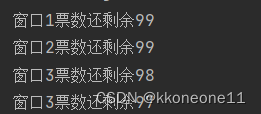一、卖票的多线程实现
需求:共有100张票,而它有3个窗口卖票,请设计一个程序模拟该电影院卖票
代码实现:
/*** @Author:kkoneone11* @name:SellTicket1* @Date:2023/8/26 11:32*/
public class SellTicket1 implements Runnable{private int tickets = 100;@Overridepublic void run() {while(true){if(tickets < 0){break;}else {try{Thread.sleep(100);}catch (Exception e){e.printStackTrace();}tickets--;System.out.println(Thread.currentThread().getName() + "票数还剩余" + tickets);}}}
}public class SellTicketDemo {public static void main(String[] args) {SellTicket1 st = new SellTicket1();Thread thread1 = new Thread(st, "窗口1");Thread thread2 = new Thread(st, "窗口2");Thread thread3 = new Thread(st, "窗口3");thread1.start();thread2.start();thread3.start();}
}
可以看到这种程序写法的问题有:
-
相同的票出现了多次
-
出现了负数的票
问题产生的原因分析:这种多线程共享的是同一份数据,线程执行的随机性导致的,可能在卖票过程中丢失cpu的执行权,导致出现问题


二、解决问题的方案
要解决这个问题实际上就是让程序没有安全问题,如何实现其实就是让每次操作的时候只能有一个线程执行成功即可,那么可以实现的方案如下:
同步代码块
实现方法:
synchronized(任意对象) { 多条语句操作共享数据的代码
}优缺点:
-
好处:解决了多线程的数据安全问题
-
弊端:当线程很多时,因为每个线程都会去判断同步上的锁,这是很耗费资源的,无形中会降低程序的运行效率
实例:
public class SellTicket1 implements Runnable{private int tickets = 100;private Object obj = new Object();@Overridepublic void run() {while(true){synchronized (obj){//当线程进来的时候就会把这段代码锁起来if(tickets <= 0){break;}else {try{Thread.sleep(100);}catch (Exception e){e.printStackTrace();}tickets--;System.out.println(Thread.currentThread().getName() + "票数还剩余" + tickets);}}//到此处锁就会释放了}}
}public class SellTicketDemo {public static void main(String[] args) {SellTicket1 st = new SellTicket1();Thread thread1 = new Thread(st, "窗口1");Thread thread2 = new Thread(st, "窗口2");Thread thread3 = new Thread(st, "窗口3");thread1.start();thread2.start();thread3.start();}
}同步方法
实现方法:
锁住的对象是:this
修饰符 synchronized 返回值类型 方法名(方法参数) { 方法体;
}静态同步方法
实现方法:
锁住的对象是:类名.class
修饰符 static synchronized 返回值类型 方法名(方法参数) { 方法体;
}实例:
public class SellTicket1 implements Runnable{private static int tickets = 100;@Overridepublic void run() {while(true){if("窗口一".equals(Thread.currentThread().getName())){//同步方法boolean b = synchronizedMthod();if(b){break;}}else if("窗口二".equals(Thread.currentThread().getName())){//同步代码块synchronized (SellTicket1.class){if(tickets == 0){break;}else{try{Thread.sleep(100);}catch (Exception e){e.printStackTrace();}tickets--;System.out.println(Thread.currentThread().getName() + "票数还剩余" + tickets);}}}}}private static synchronized boolean synchronizedMthod(){if(tickets == 0){return true;}else{try{Thread.sleep(100);}catch (Exception e){e.printStackTrace();}tickets--;System.out.println(Thread.currentThread().getName() + "票数还剩余" + tickets);return false;}}
}public class SellTicketDemo {public static void main(String[] args) {SellTicket1 st = new SellTicket1();Thread thread1 = new Thread(st, "窗口1");Thread thread2 = new Thread(st, "窗口2");Thread thread3 = new Thread(st, "窗口3");thread1.start();thread2.start();thread3.start();}
}总结:
无论synchronized关键字加在方法上还是对象上,如果它作用的对象是非静态的,则它取得的锁是对象;如果synchronized作用的对象是一个静态方法或一个类,则它取得的锁是对类,该类所有的对象同一把锁。
ReentrantLock()
如果我们想可以直接看到在哪里加上了锁,在哪里释放了锁,为了更清晰的表达如何加锁和释放锁,JDK5以后提供了一个新的锁对象Lock
| 方法名 | 说明 |
|---|---|
| void lock() | 获得锁 |
| void unlock() | 释放锁 |
实例:
public class SellTicket1 implements Runnable{//票的数量private int tickets = 100;private Object obj = new Object();private ReentrantLock lock = new ReentrantLock();@Overridepublic void run() {while (true) {//synchronized (obj){//多个线程必须使用同一把锁.try {lock.lock();if (tickets <= 0) {//卖完了break;} else {Thread.sleep(100);tickets--;System.out.println(Thread.currentThread().getName() + "在卖票,还剩下" + tickets + "张票");}} catch (InterruptedException e) {e.printStackTrace();} finally {lock.unlock();}// }}}
}public class SellTicketDemo {public static void main(String[] args) {SellTicket1 st = new SellTicket1();Thread thread1 = new Thread(st, "窗口1");Thread thread2 = new Thread(st, "窗口2");Thread thread3 = new Thread(st, "窗口3");thread1.start();thread2.start();thread3.start();}
}





:官方版本)
)






)

)


)
